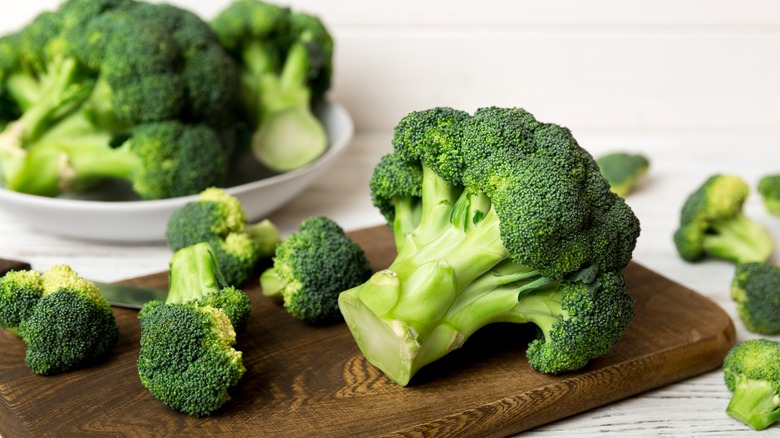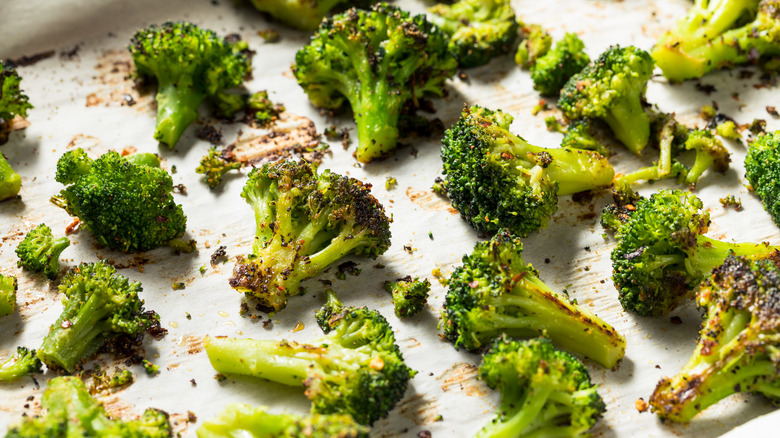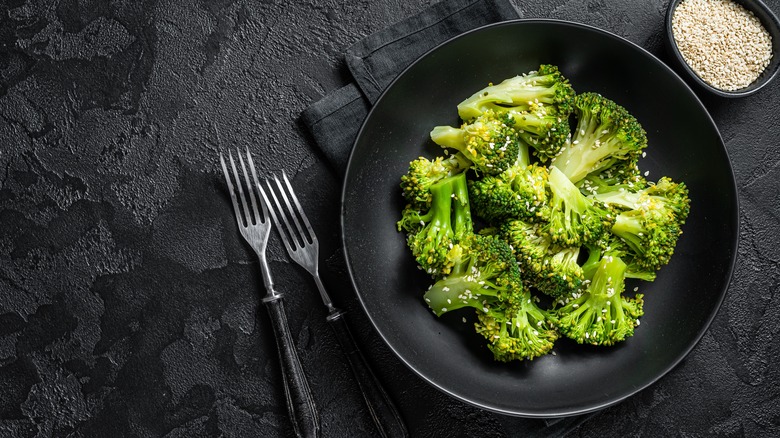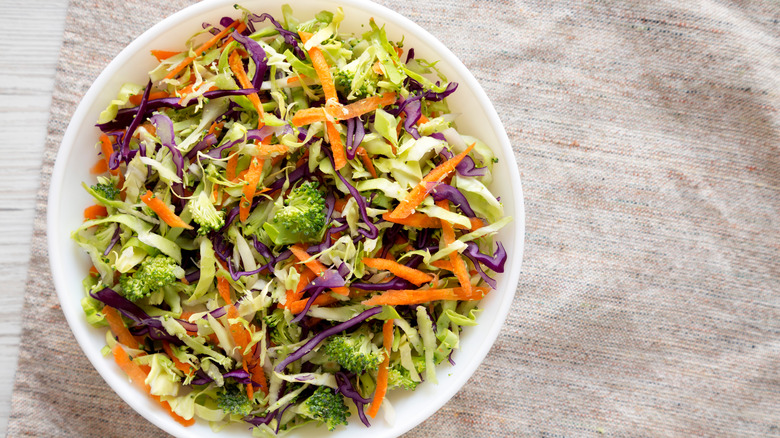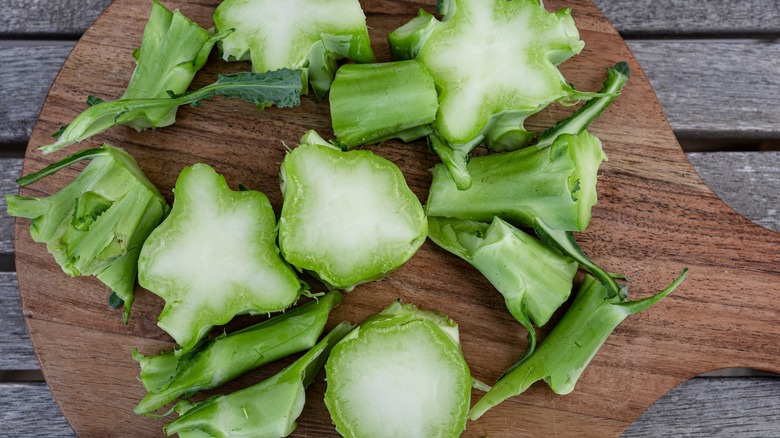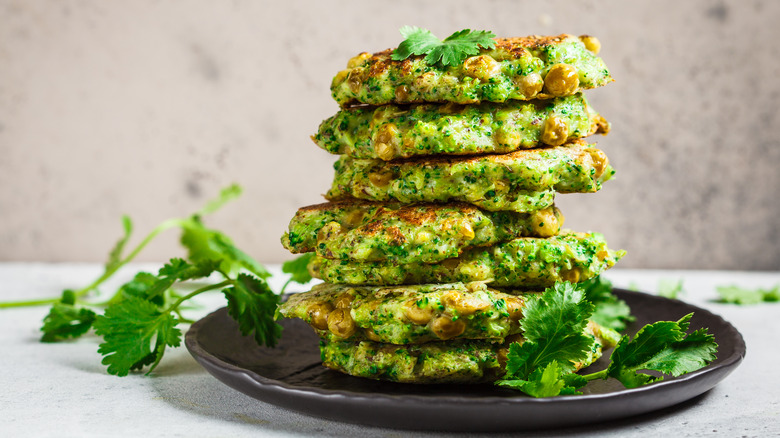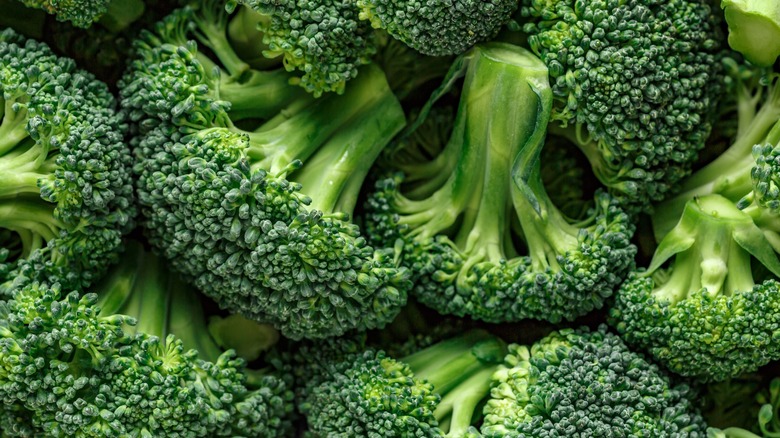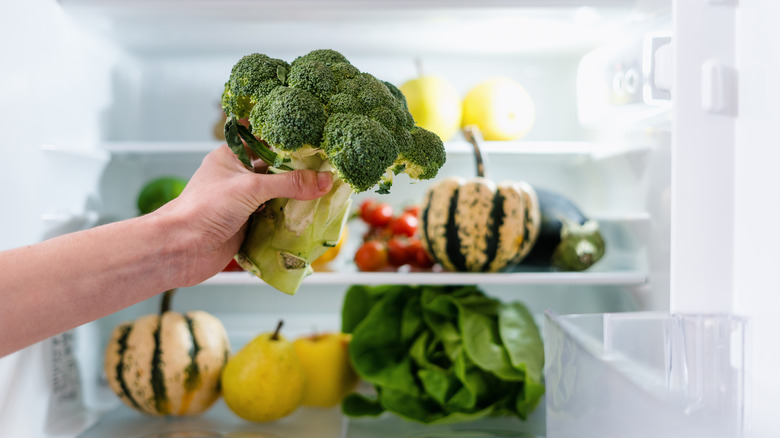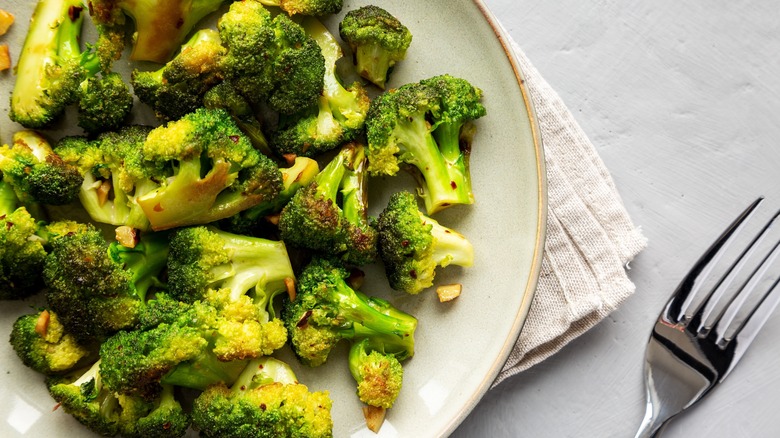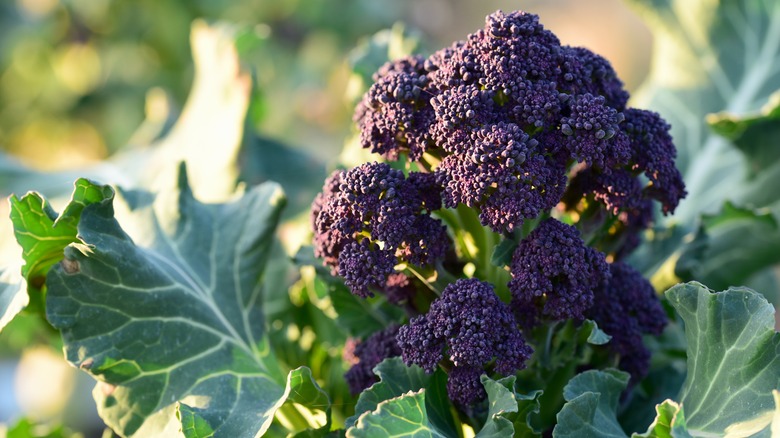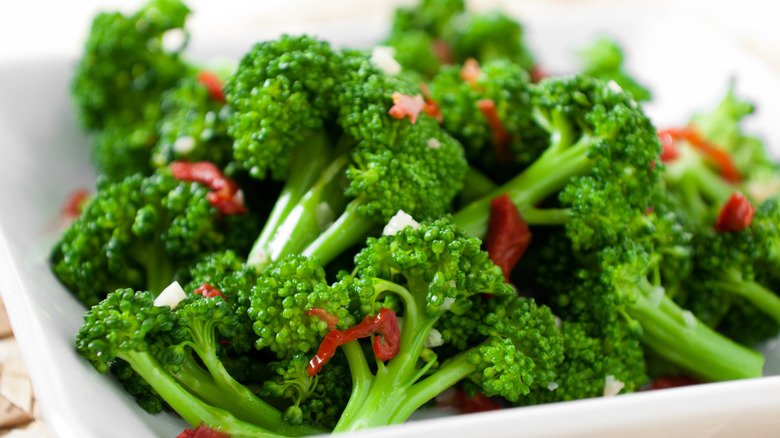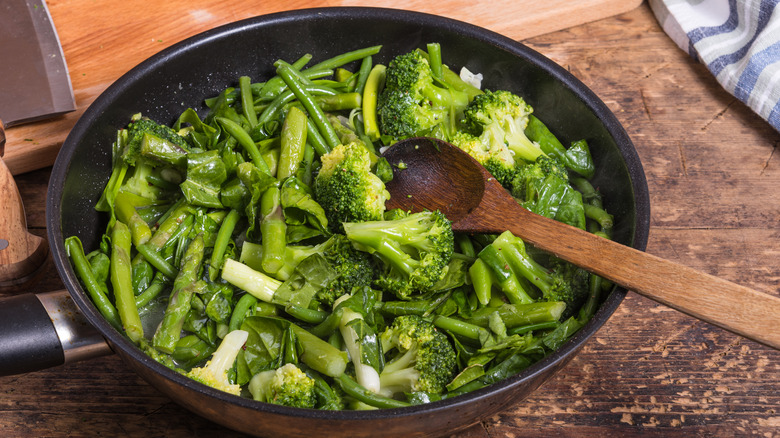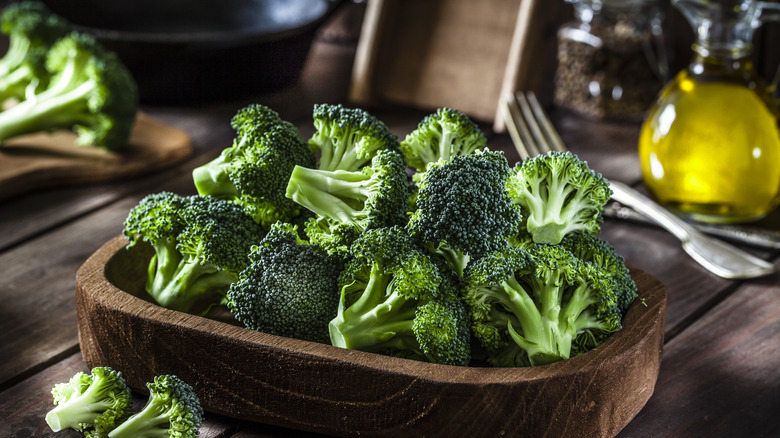Mistakes Everyone Makes With Broccoli
Some people love broccoli with a fiery passion, while others won't touch the stuff. But, whichever end of the spectrum you fall on, you might be making mistakes with broccoli. Now, if you already love broccoli, you could be making it even tastier. While, if you don't like it or think it's just okay, you might be surprised how delicious it can be once you know how to cook it right.
You might be thinking, "it's just broccoli — how hard can it be?" However, that underestimates the nuances involved with cooking. Broccoli is very easy to overcook, for instance, and that can lead to the kind of soggy, mushy broccoli you want to avoid. Many people also think that boiling or steaming are the main ways to cook broccoli, but there are actually far more delicious ways to prepare the vegetable. If you aren't getting creative enough with your recipes, you're missing out on some amazing ways to enjoy this dreamy green. But before you even get to cooking broccoli, it all starts with choosing the perfect head and storing it correctly.
See, there are more ways to go wrong with broccoli than you might have imagined. We'd be surprised if you weren't making at least a handful of these common broccoli missteps. But, luckily for you, we have the solutions you need. Now, learn about the mistakes commonly made with broccoli and how to avoid them.
Thinking boiling is the only way to cook it
If you only ever boil or steam broccoli, you're missing out on some of the tastiest preparation methods. While sometimes all you want may be some fresh, crisp lightly boiled or steamed broccoli to balance out a heavy main, these methods aren't the best way to get the most flavor out of broccoli. If you really want to make it sing, you should try some other cooking methods.
First up is roasting. This might be the MVP of the broccoli world. Roasting broccoli brings out some of its natural sweetness. You often end up with browned, caramelized parts that only serve to make broccoli even more delicious. You can even try parboiling and smashing broccoli before roasting it to make it even more crispy. You can choose to slow roast it at around 325 F for an hour or roast it at a higher heat — about 425 F — for 20 to 30 minutes.
Sautéing or stir frying is another great way to cook broccoli. It tends to stay a little firmer than roasted broccoli and its sweet flavors aren't as pronounced, but it gains some of the complexity that comes from browned and caramelized parts. You can also grill broccoli either on a gas or charcoal grill or in a grill pan. Broiling can also give you similar results to roasting in a quicker time frame — but you need to keep an eye on it as it cooks.
Overcooking
It isn't hard to overcook broccoli. Just a few extra minutes can turn it from the perfect consistency into a pile of mush. Boiling and steaming are the worst contenders for overcooking. When you roast, sauté, or use another cooking method that doesn't involve water, the cooked texture is different. While heavily roasted broccoli is soft, for instance, it isn't mushy and quick to fall apart because it doesn't get waterlogged the way that boiled and steamed broccoli does.
The best way to avoid overcooking your broccoli is to simply know how long to cook it for. Boiled broccoli takes around 3 to 5 minutes to cook. Steamed broccoli takes around 5 minutes to cook. On a side note, if you decide to steam your broccoli and find it underwhelming, there are ways you can upgrade steamed vegetables to make them tastier, such as adding fresh herbs or seasoning with garlic.
Now, these cooking times are just guidelines. They can vary depending on the size of your broccoli florets. So, it's a good idea to test the doneness of your broccoli with a fork after a few minutes and test again every minute after that to avoid the dreaded mush.
Not trying it raw
We've talked about cooking methods for broccoli and how to avoid overcooking — but what about not cooking it at all? Bear with us here. If you aren't used to eating broccoli raw, it might sound strange, but it's actually delicious. You get the fresh, earthy, vegetal flavors of broccoli coming through, with a lovely crunch.
You can simply eat raw broccoli florets. Just break the florets off the main stem and eat them plain as a crunchy snack or serve them with your favorite dip such as hummus, ranch dressing, or tzatziki. But, if you've never eaten raw broccoli before, this is starting on hard mode. You might want to ease yourself in with a less intense option.
For instance, you could make a broccoli salad by chopping raw broccoli florets into small chunks and mixing them in with other vegetables like cherry tomatoes, red onions, and bell peppers. Toss it with a vinaigrette or creamy dressing for added flavor. There's also the option to make broccoli slaw. Shred raw broccoli florets using a grater or food processor to create a slaw-like texture. Mix with shredded carrots, cabbage, and mayo for an alternative take on classic coleslaw.
Throwing out the stems
If you've been throwing out your broccoli stems all these years, you need to stop. Like, right now. A head of broccoli comes with all those deep green florets but you also get some stalk thrown in for free. You might think that having to remove the stem yourself is a chore. But, if you've been removing and discarding it, you've been throwing away some of the best bits. It's like getting a two-for-one offer at the store and throwing out the free item. Broccoli stems aren't just a freebie, they're a delicious one. The flavor is slightly milder than the florets — a lot like the mysterious vegetable that is kohlrabi.
So, how do you make the most of your broccoli stems? Start by cutting a couple of inches off the bottom of the stalk. This part is generally too tough and fibrous to be enjoyable. Then, think about the cooking method. The skin of the stalk can be slightly tough, so if you're opting for a quick cook — such as stir frying — you should peel the stem before chopping it. If you're roasting or using another method that involves a long cooking time, the skin will soften up enough so there's no need to peel it. Then, slice it into thin rounds or dice and cook it alongside your broccoli florets.
Not trying interesting recipes
There's more to broccoli than just steaming, sautéing, or roasting it and eating it as a side. Dropping it into stir fries and curries is a start, but there are even more interesting broccoli recipes where it takes center stage. And, if you aren't seeking out any of these recipes, then you're missing out on some of the most exciting things you can do with broccoli.
One of the best things I've ever eaten involving broccoli was a deep-fried, battered broccoli fritter from a tapas restaurant in Trondheim. I think about it often. Battering and deep frying is always a winner if you want to take something to the next level, but it might not be in your everyday cooking rotation. No matter. There are plenty more broccoli-forward recipes you can try.
Broccoli soup is a great place to start. It's especially great paired with cheddar or blue cheese. It's also delicious on toast, smashed or blanketed with melted cheese. You can make a take on cauliflower cheese with broccoli in place of cauliflower or add some florets to a baked mac and cheese. It also tastes great in frittatas or quiches. It's just so versatile that there's no lack of interesting broccoli recipes to try.
Choosing broccoli that's past its best
Cooking broccoli the right way is important. But, if you start with a head that's past its best, you aren't going to get the results you're looking for. Even if the broccoli isn't off and bad to eat, it might not be at its most flavorful or have the best texture. Or it could be fine when you buy it but go off after a day or two in the fridge.
But, what should you check for when selecting broccoli? Look for broccoli heads that have a vibrant blue-green color. Avoid broccoli with yellowing or browning florets, as it may be past its prime. The florets should be tightly closed and compact. Avoid broccoli with florets that are starting to separate or have begun to bloom (open up), as this indicates it is no longer fresh.
Gently squeeze the head. It should feel firm and tightly packed. Avoid broccoli with soft spots or areas that feel mushy. Also check the stem — it should be firm and sturdy. Don't pick broccoli with limp or rubbery stems, as this is a sign it's on its way out. It's also worth smelling the broccoli. It should have a fresh, slightly sweet smell. Avoid broccoli with a strong or unpleasant odor. This is a sign of bacterial growth.
Storing it incorrectly
You've bought a perfectly fresh head of broccoli from the store or the farmers market. But, you aren't planning on using it right away. It's important that you know how to store it correctly so that it doesn't go bad before its time. Broccoli generally lasts only five days at most in the fridge. But it can go bad even quicker if you store it wrong, so be careful.
Place unwashed broccoli in a perforated plastic bag or a loosely wrapped plastic bag in the crisper drawer of your refrigerator. If it came shrink wrapped, take it out of its original packaging. Don't cram it in too tightly with other veggies, though. Give it some room to breathe. What you need is proper air circulation, which prevents ethylene gas and moisture buildup that can cause the broccoli to spoil quickly. You should also make sure that the broccoli isn't damp when storing it in the fridge. This is why it's best to store it unwashed. But, if it's already damp when you get it home, dry it off and store with paper towels to absorb excess moisture.
Broccoli is technically a flower head. Another way to store it is to treat it like a bunch of fresh flowers. Cut an inch or two off the stem and store it, stem down, in a glass or jar of water in the fridge. It will drink water through the stem, staying fresh for longer.
Not letting it brown when roasting or sautéing
If you think that brown equals burned when cooking broccoli, you aren't making the most of the complex flavors that browning can bring out in broccoli. In fact, one of the biggest mistakes you're making might be moving broccoli around in the pan too much while sautéing instead of letting it sit and brown. Or, maybe you're taking it out of the oven too soon, before it's got some color to it.
But, why is browning good? There's something called the Maillard reaction that happens when food reaches a certain temperature and is allowed to brown. You don't need to understand the ins-and-outs of the science, but basically the Maillard reaction involves certain chemical bonds in foods breaking and being rearranged. This forms new flavors and explains why your roasted or sautéed broccoli tastes so different from its steamed or boiled counterparts.
There's also caramelization, which is related to the Maillard reaction, but isn't exactly the same thing. Caramelization is when the sugars in foods break down and brown, which — like the Maillard reaction — forms new flavors. This process occurs when broccoli browns and brings out a sweeter side to the vegetable.
Ignoring other types of broccoli
When you think about broccoli, you probably picture the type with a large, thick stalk and tight head made up of multiple florets. But, this isn't the only type of broccoli there is. If you're treating it as such and ignoring the other varieties, then you're missing out on some delicious options.
So, what other types of broccoli are there? Well, there's broccoli rabe — or rapini — a leafy green vegetable with small broccoli-like buds and a bitter flavor. It has thinner stems and leaves than broccoli, and its taste is more pungent and peppery. And what about purple sprouting broccoli? Well, this is a variety with slender stalks and small, purple-tinged florets. It's known for its slightly sweeter taste and tender texture compared to traditional broccoli.
We also have Chinese broccoli, or Gai Lan, which is a leafy green vegetable popular in Chinese cuisine. It features thick, flat leaves and stems with small, undeveloped flower buds. It has a slightly bitter taste compared to regular broccoli. Now, let's talk about broccolini. What is broccolini and how does it compare to regular broccoli? It's a cross between broccoli and Chinese broccoli. It resembles broccoli but has smaller florets and longer, slender stems. It has a milder flavor with a hint of sweetness.
Not seasoning it properly
One of the reasons for your broccoli woes might simply be that you aren't seasoning it properly. If you're avoiding seasoning it altogether or only giving it a light touch, this may be the reason for your subpar broccoli. Broccoli likes plenty of salt, and this is a great place to start, but you can certainly go beyond salt and pepper.
If you're roasting it, one option is to add salt, a fat, an acid, and an additional herb or spice. This is the perfect template for making a broccoli dish your own. So, you might start with olive oil, lemon juice, and oregano. Or, sesame oil, rice vinegar, and sriracha hot sauce. It's customizable to create the kind of flavor profile you want.
Then, there are blends of seasonings and other flavor-boosters that you can use to season any kind of broccoli. It'll even liven up bland steamed broccoli. You could try smoked paprika and garlic, lemon and basil, brown butter and garlic, curry powder, garam masala, teriyaki sauce, or za'atar. These are just a few of the many options you have for flavoring broccoli, so there's no excuse for it not to be tasty.
Stir frying or sautéing broccoli while it's wet
Naturally, you want to wash your broccoli before throwing it into the pan. But, if you go straight from rinsing to stir frying, it's a surefire way to end up with limp, soggy broccoli. The problem is with adding broccoli (and other vegetables) to the pan wet. The added water means you end up braising or steaming your broccoli instead of truly sautéing or stir frying it. So, while you were expecting something crisp and fresh, you end up with a soupy mush.
We wouldn't recommend skipping the washing step (unless you buy pre-washed produce), but we know that some people have a more lax approach to washing veggies than others. So, if you choose to simply not wash your broccoli, you can keep that between you and your kitchen faucet. However, those of us who wash our broccoli before cooking should make sure to thoroughly dry it before cooking it in a hot pan. This way, you'll end up with crisp broccoli with a nice degree of browning, rather than a soggy stir fry.
Using too little oil
Oil gets a bad rap. People are afraid of the fat content. But, the fact is that oil is a vehicle for flavor and it's a big part of what makes good food taste great. So, if you're using too little oil when roasting, sautéing, or even air frying your broccoli, that might be where you're going wrong. So, embrace oil and make your broccoli taste even better. Of course, the exact amount of oil you need depends on the recipe, pan size, and how much broccoli you're cooking, but be generous.
The other thing to think about is the type of oil you use. Some oils are more flavorful than others. For instance, olive oil, toasted sesame oil, and virgin avocado oil all bring notable flavors to the party. There are other oils with more neutral flavors, such as canola oil and grapeseed oil. These are good choices when you want other flavors and seasonings to come through more than the taste of the oil. However, whichever option you choose, you should make sure to avoid oils with a low smoke point when you're roasting broccoli.
